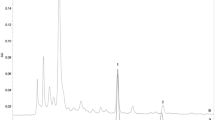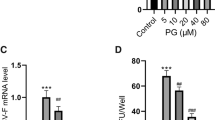Abstract
Explore the influence of baicalin joint resveratrol retention enema on TNF-α, SIgA, IL-2, and IFN-γ of rats with respiratory syncytial virus (RSV) infection. The 60 SD rats were randomly divided into normal group, model group, baicalin group, resveratrol group, joint group, and ribavirin group. For model group, baicalin group, resveratrol group, joint group, and ribavirin group, rats were given RSV virus suspension intranasally for 3 days, and model group was not given administration. Baicalin group, resveratrol group, joint group, and ribavirin group were, respectively, given baicalin 100 mg/kg/day, resveratrol 30 mg/kg/day, baicalin joint resveratrol, and ribavirin 1 g/kg/day retention enema. After continuously given administration 7 days, rats were measured in serum TNF-α, IL-2, IFN-γ levels and SIgA levels in bronchoalveolar lavage fluid. Model group, TNF-α, IL-2, IFN-γ, and SIgA were significantly higher than the normal group (P < 0.05); Baicalin group, resveratrol group, ribavirin group, TNF-α, IL-2, IFN-γ, and SIgA were significantly higher than the model group (P < 0.05); TNF-α, IL-2 between baicalin group, resveratrol group, ribavirin group, have no significant difference (P > 0.05); Baicalin group, resveratrol group, joint group, IFN-γ, and SIgA were significantly higher than the ribavirin group (P < 0.05); Joint group TNF-α, IL-2, IFN-γ, and SIgA were significantly higher than baicalin group, resveratrol group, and ribavirin group (P < 0.05). Baicalin joint resveratrol retention enema can increase RSV infection model in rats serum TNF-α, IL-2, IFN-γ levels and SIgA levels in bronchoalveolar lavage fluid, which may anti-virus through this mechanism.
Similar content being viewed by others
References
Drago, L., et al. (2008). In vitro antiviral activity of resveratrol against respiratory viruses. Journal of Chemotherapy, 20(3), 393–394.
Zang, N., et al. (2011). Resveratrol-mediated gamma interferon reduction prevents airway inflammation and airway hyperresponsiveness in respiratory syncytial virus-infected immunocompromised mice. Journal of Virology, 85(24), 13061–13068.
Chai, Y. S., et al. (2013). Effect of baicalin on pattern recognition receptor TLR2/4-NOD2 and its significance of druggability. Zhongguo Zhong Yao Za Zhi, 38(16), 2639–2644.
Chen, M. L., et al. (2013). Resveratrol attenuates vascular endothelial inflammation by inducing autophagy through the cAMP signaling pathway. Autophagy, 9(12), 2033–2045.
Lopes Costa, A., et al. (2014). Beneficial effects of resveratrol on respiratory chain defects in patients’ fibroblasts involve estrogen receptor and estrogen-related receptor alpha signaling. Human Molecular Genetics, 23(8), 2106–2119.
Zhu, J., et al. (2012). Baicalin improves survival in a murine model of polymicrobial sepsis via suppressing inflammatory response and lymphocyte apoptosis. PLoS One, 7(5), e35523.
Fu, S., et al. (2012). Anti-inflammatory effects of active constituents extracted from Chinese medicinal herbs against Propionibacterium acnes. Natural Product Research, 26(18), 1746–1749.
Li, Q., & Ge, X. (2010). Effect of baicalin on antipyresis and influence on cytokine. Zhongguo Zhong Yao Za Zhi, 35(8), 1068–1072.
Chothe, P. P., & Swaan, P. W. (2014). Resveratrol promotes degradation of the human bile acid transporter ASBT (SLC10A2). Biochemical Journal, 459(2), 301–312.
Zhou, L., & Zhou, B. Y. (2009). Influence of baicalin on TNF-alpha and soluble intercellular adhesion molecule-1 in rats infected with Pneumocystis carinii. Zhongguo Ji Sheng Chong Xue Yu Ji Sheng Chong Bing Za Zhi, 27(2), 144–147.
Dou, Y., et al. (2013). Respiratory syncytial virus infection induces higher Toll-like receptor-3 expression and TNF-alpha production than human metapneumovirus infection. PLoS One, 8(9), e73488.
Schijf, M. A., et al. (2013). Respiratory syncytial virus induced type I IFN production by pDC is regulated by RSV-infected airway epithelial cells, RSV-exposed monocytes and virus specific antibodies. PLoS One, 8(11), e81695.
Diaz, P. V., et al. (2012). Increased expression of the glucocorticoid receptor beta in infants with RSV bronchiolitis. Pediatrics, 130(4), e804–e811.
Liu, X., et al. (2013). Progressive changes in inflammatory and matrix adherence of bronchial epithelial cells with persistent respiratory syncytial virus (RSV) infection (progressive changes in RSV infection). International Journal of Molecular Sciences, 14(9), 18024–18040.
Li, J., et al. (2012). Regulation trend of resveratrol on TNFalpha-, IL-1beta, IL-6 expressions in bronchoalveolar lavage fluid of RSV-infected BALB/c mice. Zhongguo Zhong Yao Za Zhi, 37(10), 1451–1454.
Guo, A. J., et al. (2011). Baicalin, a flavone, induces the differentiation of cultured osteoblasts: An action via the Wnt/beta-catenin signaling pathway. Journal of Biological Chemistry, 286(32), 27882–27893.
Xiong, J., et al. (2013). A beta-induced microglial cell activation is inhibited by baicalin through the JAK2/STAT3 signaling pathway. International Journal of Neuroscience. doi:10.3109/00207454.2013.865027.
Xiping, Z., et al. (2009). Influence of baicalin on TNF-alpha mRNA, caspase-3 and P-selectin expression in pancreatic tissue of rats with severe acute pancreatitis. Indian Journal of Gastroenterology, 28(4), 131–135.
Tian, H., et al. (2009). Effects of baicalin and octreotide on the serum TNF-alpha level and apoptosis in multiple organs of rats with severe acute pancreatitis. Inflammation, 32(3), 191–201.
Zhang, P., et al. (2013). Baicalin protects rat brain microvascular endothelial cells injured by oxygen–glucose deprivation via anti-inflammation. Brain Research Bulletin, 97, 8–15.
Hou, J., et al. (2012). Baicalin attenuates proinflammatory cytokine production in oxygen–glucose deprived challenged rat microglial cells by inhibiting TLR4 signaling pathway. International Immunopharmacology, 14(4), 749–757.
Basavaraj, S., & Betageri, G. V. (2014). Improved oral delivery of resveratrol using proliposomal formulation: Investigation of various factors contributing to prolonged absorption of unmetabolized resveratrol. Expert Opinion on Drug Delivery, 11(4), 493–503.
Liu, T., et al. (2014). Resveratrol inhibits the TRIF-dependent pathway by upregulating sterile alpha and armadillo motif protein, contributing to anti-inflammatory effects after respiratory syncytial virus infection. Journal of Virology, 88(8), 4229–4236.
Xie, X. H., et al. (2012). Resveratrol inhibits respiratory syncytial virus-induced IL-6 production, decreases viral replication, and downregulates TRIF expression in airway epithelial cells. Inflammation, 35(4), 1392–1401.
Guo, R., et al. (2014). Resveratrol ameliorates diabetic vascular inflammation and macrophage infiltration in db/db mice by inhibiting the NF-kappaB pathway. Diabetes, Obesity and Metabolism, 11(2), 92–102.
Lin, L., et al. (2010). The anti-inflammatory effect of baicalin on hypoxia/reoxygenation and TNF-alpha induced injury in cultural rat cardiomyocytes. Phytotherapy Research, 24(3), 429–437.
Guan, W. D., et al. (2008). In vitro experimental study on the effect of resveratrol against several kinds of respiroviruses. Zhong Yao Cai, 31(9), 1388–1390.
Author information
Authors and Affiliations
Corresponding author
Rights and permissions
About this article
Cite this article
Cheng, K., Wu, Z., Gao, B. et al. Analysis of Influence of Baicalin Joint Resveratrol Retention Enema on the TNF-α, SIgA, IL-2, IFN-γ of Rats with Respiratory Syncytial Virus Infection. Cell Biochem Biophys 70, 1305–1309 (2014). https://doi.org/10.1007/s12013-014-0055-9
Published:
Issue Date:
DOI: https://doi.org/10.1007/s12013-014-0055-9




